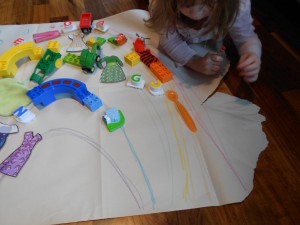As kids play with Lego and Duplo, they are learning and developing important brain connections and thinking skills that will help with kindergarten readiness. Did you know that asking kids about colors is often included as part of a school’s evaluation? This gives teachers an idea of a child’s level of thinking skills. Kids who are having difficulty learning colors may be struggling with other concepts as well.
 Learning colors is a challenging thinking skill. First, there’s many variations of each and every color name: blue can be pale, dark, greeny or kind of purple and it’s still called blue. Second, very different objects can be the same color, such as green trees, green olives, and green grass. Third, not everybody agrees all the time on what to call a particular color. I have a coat that is deep pink that some adults call red. This can all be very confusing.
Learning colors is a challenging thinking skill. First, there’s many variations of each and every color name: blue can be pale, dark, greeny or kind of purple and it’s still called blue. Second, very different objects can be the same color, such as green trees, green olives, and green grass. Third, not everybody agrees all the time on what to call a particular color. I have a coat that is deep pink that some adults call red. This can all be very confusing.
In order to learn colors, kids need to see many examples for each and every color. Gradually, they figure out which shades go with which name. Lego and Duplo have bright, basic colors. The standard red, green, yellow, and blue blocks definitely match their names. There are a variety of accessories in different colors, such as the farm and zoo animals, but they are not wild combinations.
As your child plays, you can comment using color words, such as: “Oh, you have a yellow block on the bottom and blue on top.” Or, “That block is red, like your shirt.” Take a minute to play too and ask your child to pass you a block of a particular color. You can ask your child to tell you the color of a piece. All these little bits accumulate to support your child to make the brain connections needed for colors. No matter its color, do you agree that Lego is the ‘gold’ at the end of the rainbow for learning?
